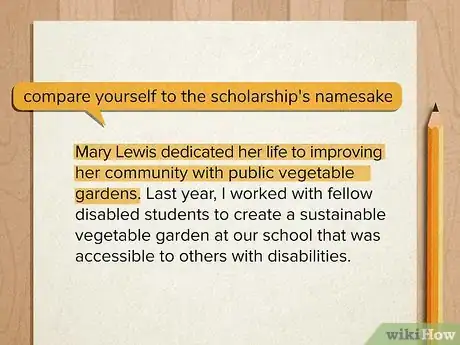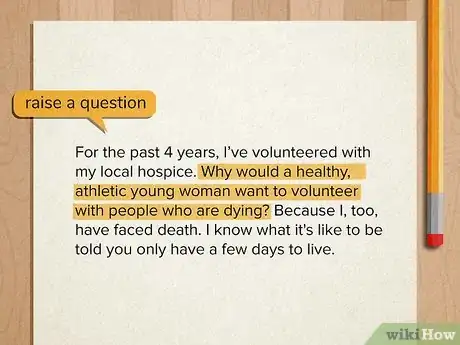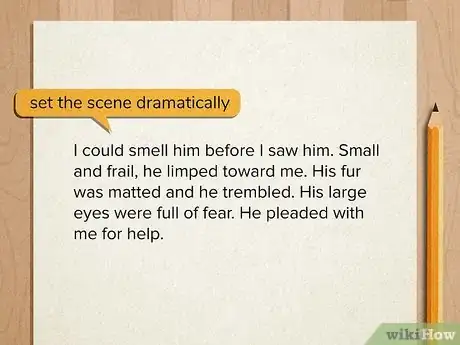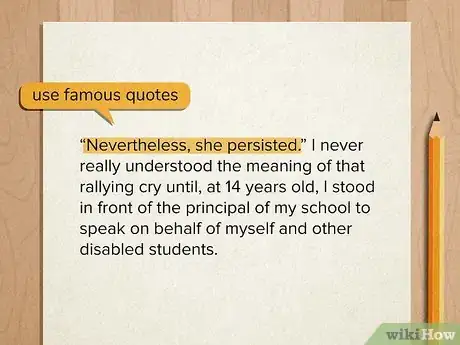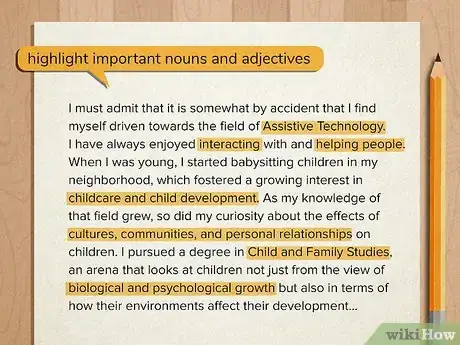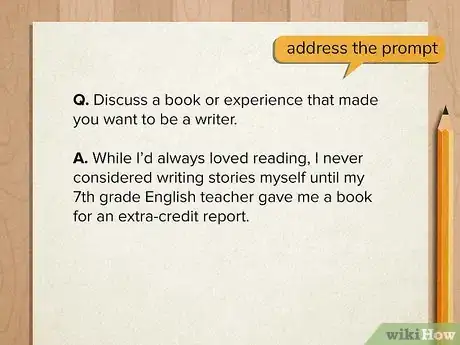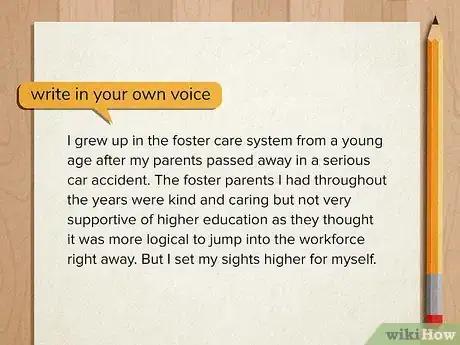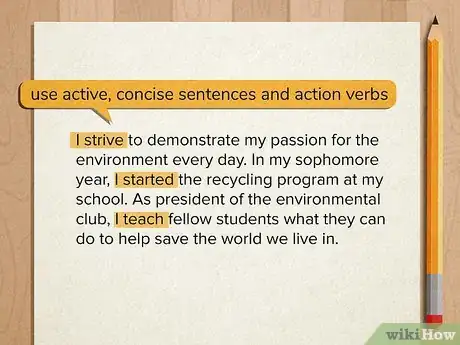This article was co-authored by Jake Adams and by wikiHow staff writer, Jessica Gibson. Jake Adams is an academic tutor and the owner of Simplifi EDU, a Santa Monica, California based online tutoring business offering learning resources and online tutors for academic subjects K-College, SAT & ACT prep, and college admissions applications. With over 14 years of professional tutoring experience, Jake is dedicated to providing his clients the very best online tutoring experience and access to a network of excellent undergraduate and graduate-level tutors from top colleges all over the nation. Jake holds a BS in International Business and Marketing from Pepperdine University.
There are 10 references cited in this article, which can be found at the bottom of the page.
This article has been viewed 75,518 times.
College scholarships can be incredibly competitive and most of them have an essay component. While you may dread writing these essays, they're nothing to fear—the scholarship committee just wants to know a little more about you. With a strong introduction that hooks your reader, you're halfway there! But how do you start a scholarship essay? Here, you'll find some great ideas for how to start, along with some general writing strategies that you can carry through to the rest of your essay.
Steps
Expert Q&A
Did you know you can get premium answers for this article?
Unlock premium answers by supporting wikiHow
-
QuestionWhat should a scholarship essay look like?
 Jake AdamsJake Adams is an academic tutor and the owner of Simplifi EDU, a Santa Monica, California based online tutoring business offering learning resources and online tutors for academic subjects K-College, SAT & ACT prep, and college admissions applications. With over 14 years of professional tutoring experience, Jake is dedicated to providing his clients the very best online tutoring experience and access to a network of excellent undergraduate and graduate-level tutors from top colleges all over the nation. Jake holds a BS in International Business and Marketing from Pepperdine University.
Jake AdamsJake Adams is an academic tutor and the owner of Simplifi EDU, a Santa Monica, California based online tutoring business offering learning resources and online tutors for academic subjects K-College, SAT & ACT prep, and college admissions applications. With over 14 years of professional tutoring experience, Jake is dedicated to providing his clients the very best online tutoring experience and access to a network of excellent undergraduate and graduate-level tutors from top colleges all over the nation. Jake holds a BS in International Business and Marketing from Pepperdine University.
Scholarship & Admissions Counselor
-
QuestionWhat grade should you start applying for scholarships?
 wikiHow Staff EditorThis answer was written by one of our trained team of researchers who validated it for accuracy and comprehensiveness.
wikiHow Staff EditorThis answer was written by one of our trained team of researchers who validated it for accuracy and comprehensiveness.
Staff Answer wikiHow Staff EditorStaff Answer
wikiHow Staff EditorStaff Answer -
QuestionWhat is a good way to start a scholarship essay?
 Drew Hawkins1Community AnswerThere are a couple of ways you can start a scholarship essay. If the scholarship was created to honor a specific person, you can try comparing yourself to them demonstrate what you have in common with the namesake. Read up on that person and find out what you have in common with them. Drawing parallels between their life and yours could give you a leg up for the scholarship. It's also a good idea to reference some of the buzzwords in the essay prompt. Make it so many, if not all, of these words appear in the first paragraph of your essay. This lets the reader know that you're paying attention to the prompt and addressing it directly. Remember, most scholarships are designed to benefit a specific type of person (a Southern writer or a woman from Kentucky, for example). So if you can show how you're the perfect person for the scholarship, it can help boost your chances.
Drew Hawkins1Community AnswerThere are a couple of ways you can start a scholarship essay. If the scholarship was created to honor a specific person, you can try comparing yourself to them demonstrate what you have in common with the namesake. Read up on that person and find out what you have in common with them. Drawing parallels between their life and yours could give you a leg up for the scholarship. It's also a good idea to reference some of the buzzwords in the essay prompt. Make it so many, if not all, of these words appear in the first paragraph of your essay. This lets the reader know that you're paying attention to the prompt and addressing it directly. Remember, most scholarships are designed to benefit a specific type of person (a Southern writer or a woman from Kentucky, for example). So if you can show how you're the perfect person for the scholarship, it can help boost your chances.
Warnings
- Typos can ruin an otherwise beautiful essay! Make sure you proofread carefully.[17]⧼thumbs_response⧽
References
- ↑ https://scholarshipowl.com/blog/apply-for-scholarships/scholarship-essay-introduction/
- ↑ https://www.owens.edu/writing/scholarship/
- ↑ https://www.owens.edu/writing/scholarship/
- ↑ https://www.owens.edu/writing/scholarship/
- ↑ https://www.nitrocollege.com/blog/how-to-start-a-scholarship-essay
- ↑ https://www.thecollegemonk.com/blog/scholarship-essay-introduction
- ↑ Jake Adams. Academic Tutor & Test Prep Specialist. Expert Interview. 20 May 2020.
- ↑ https://www.owens.edu/writing/scholarship/
- ↑ Jake Adams. Academic Tutor & Test Prep Specialist. Expert Interview. 20 May 2020.
- ↑ https://www.usnews.com/education/best-colleges/paying-for-college/articles/ways-to-make-your-scholarship-essay-stand-out
- ↑ https://www.internationalstudent.com/essay_writing/scholarship_essaysample/
- ↑ https://online.maryville.edu/blog/how-to-write-a-scholarship-essay/
- ↑ Jake Adams. Academic Tutor & Test Prep Specialist. Expert Interview. 20 May 2020.
- ↑ https://www.usnews.com/education/best-colleges/paying-for-college/articles/ways-to-make-your-scholarship-essay-stand-out
- ↑ https://www.owens.edu/writing/scholarship/
- ↑ https://libanswers.library.cqu.edu.au/faq/169732
- ↑ https://www.southuniversity.edu/news-and-blogs/2013/05/8trickstowritingstandoutscholarshipessays
About This Article
To start a scholarship essay, open with an interesting story, experience, or anecdote to draw your reader in. Then, connect your opening to the broader topic or question you'll be addressing throughout your essay. If you need some inspiration for a good introduction, read the essays written by the previous winners of the scholarship you're applying for. Just make sure you use your own voice and experiences to write your essay so it comes across as authentic. To learn how to conduct research for your scholarship essay before you write it, scroll down!


